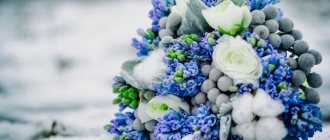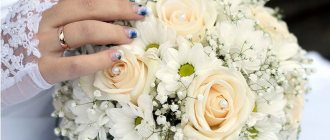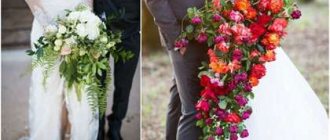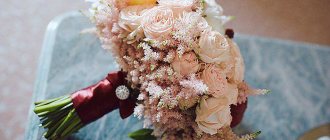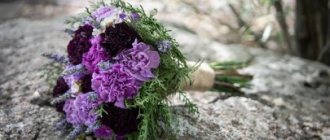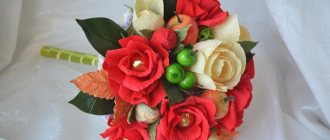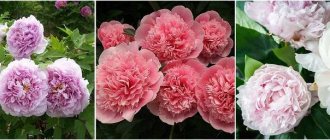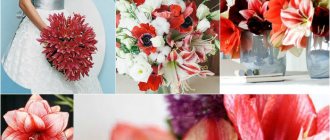What does it symbolize
White and green shades look fresh and juicy. The bride's white and green bouquet symbolizes blossoming and love of life and is associated with spring and rebirth. When composing, you need to take into account that the tone of the colors should be combined with the trim on the dress. Green color is rich in shades from muted to bright. Stylists claim that the apple shade suits all women without exception.
If the bride is thinking of wearing a green dress for her wedding ceremony, then you should pay attention to the combination of shades described below.
- The Winter Girl will look harmonious in a mint-colored outfit.
- Lime and light green colors suit spring girls.
- Summer girls look good in dresses in soft colors, such as cabbage.
- For an Autumn girl, it is best to pay attention to pistachio and khaki colors.
- Green color is associated with tranquility and closeness to nature. It goes well with shades of white - cream, pearl, milky, snow-white.
- A green and white bouquet is usually chosen for summer or spring weddings, but you can choose flowers in these shades for a winter ceremony. For a winter wedding, choose plants of brighter colors.
If the bride chooses a classic white dress, it is better to prefer jewelry with green stones - malachite, emerald, tourmaline. Choose shoes, a belt and a handbag to match. The groom's suit is completed with a green bow tie and a flower boutonniere.
Interesting! Our second article about green wedding composition is here. It also contains beautiful photos.
Role
The bouquet is an integral part of the bride’s image, and therefore the unified image of the newlyweds.
It can add tenderness or emphasize discreet elegance, be an elegant addition or act as a bright, attention-grabbing accent, become a symbol of fun or discreet solemnity of the moment
Must be selected taking into account:
- place and time of the wedding;
- styles and colors of wedding dresses;
- appearance of the bride and groom;
- preferences of the bride and groom;
- will there be other flowers in the dresses of the bride and groom, as well as bridesmaids;
- what flowers will be used to decorate the hall;
- Will the groom have a boutonniere?
There are dozens of types of wedding bouquets for the bride, but their choice primarily depends on the type of arrangement.
Possible assembly options are below.
- Collected from stems. These look simple and elegant, they are inexpensive, durable and non-traumatic, but the flowers can quickly wither.
- In a portaquet. A more complex, but also more durable option. Flowers are stuck into a damp sponge, which allows them to remain fresh longer. This type of assembly allows you to create complex options, but they are quite heavy and can cause injury to the girls who catch them.
- Taped. These bouquets are assembled from flowers, the stems of which are first cut off, and the flowers are attached to wire. Taped ones allow you to show creativity, but they are expensive, can quickly wither, and it is not advisable to throw them away.
What plants go together?
A white and green bouquet is suitable for weddings in nautical, rustic, and retro styles. White and green combinations are also considered in the design of classic and fashionable weddings.
- Fern. A fern bouquet is suitable for a forest wedding. An exotic bouquet is made from the leaves of this non-flowering plant and lilies or orchids. It is easy to construct a drop bouquet from ferns, which is ideal for tall and slender brides. A combination of fern and calla lilies is suitable for a Greek outfit.
- Tulips. Green-flowered tulips will go well with a classic bride's dress. When composing, white tulips are placed in the center, green ones - along the edges. The stems are tied with a wide white ribbon. This bouquet is simple on the one hand, and delicate and elegant on the other.
- Green rose. The green rose symbolizes emerging feelings. White buds emphasize the tenderness of relationships.
- Succulents. Succulents go with any plant. Compositions with white roses and peonies are romantic and creative. In combination with wildflowers, the result is an extremely cozy “country” composition that is suitable for a country wedding.
- Moss. It has ceased to be something exotic. Florists are happy to decorate compositions of roses and anemones with this material. A bouquet of moss, ferns, peonies, and green carnations looks fantastic.
- Orchids. Herbaceous and white, orchids look discreet and elegant. Green orchids combine with roses. Among the laconic combinations are orchids and alstroemeria.
- Viburnum and sweet pea. You can create a custom bouquet from viburnum inflorescences. Sweet peas, beloved by florists, are used as an addition. Its small flowers go well with the unusually shaped Vibyrnum.
- Green carnation. Red carnations are hardly suitable, but soft green ones look fresh and unusual. Combines with other flowers or used in a mono bouquet.
Bouquets can be composed of coniferous branches, rosemary, asparagus, ruscus and salal and diluted with apple blossoms, white lilacs, daisies, gerberas, dahlias. A bouquet of unblown chrysanthemums and white roses looks fabulous. Green eucalyptus goes well with freesias and peonies. Lilies of the valley with wide leaves make a delicate white-green bridal bouquet. A photo of a good example is above.
What to combine white flowers with?
There are several options for interesting and original combinations. One of them could be the use of bugles or beads. Often, florists use non-natural materials to create a bouquet.
For example, they plant a butterfly on a long stick in the bouquet itself, thus visually creating the impression that the butterfly has flown to one of the flowers in the bouquet. In addition to this move, beads and glass beads are also used, which are placed on a thread and wrapped around a flower arrangement.
It would be appropriate to combine a white bouquet with decorative leaves, which will add special freshness and dilute the bride’s wedding image. It is also possible to combine several plant varieties at once. For example, carnations and orchids look creative. On the one hand, thanks to the carnations, the flower will turn out to be a lush one, and on the other hand, it will look graceful and sophisticated.
How to choose a mono bouquet
A bouquet consisting entirely of green plants does not overload the image and looks democratic. For him they most often take:
- green chrysanthemums;
- fern, lichen and moss;
- green orchids;
- roses;
- gladioli;
- parrot tulips;
- eustoma;
- dendrobium;
- molucella;
- hydrangeas;
- anthurium.
Attention! To prevent the bouquet from looking too simple, different types of greenery are combined with each other, the composition is diluted with berries and leaves of various shapes. A green bouquet is suitable for an elven wedding or for a traditional wedding near a lake and forest.
We save the wedding bouquet as a keepsake
Do you want to keep your wedding bouquet as a keepsake? How to properly turn it into a herbarium?
Carefully remove each flower from the bouquet. To do this, you need to get rid of fastenings - paper clips, ropes or rubber bands.
Remove foam, wrapping paper and other decorative elements. Have you noticed that the bouquet has begun to rot at the stems? So, take sharp scissors and carefully cut off all the rotten areas. Connect the plants together by fastening the stems (thread or paper clip). The best option would be twine. After this, you need to hang the bride's flowers upside down. It is recommended to hang flowers in a closet or in a place where there is a free surface. Leave the wedding bouquet in this position for approximately 6 weeks.
As a result, you will receive a dried wedding bouquet that will become a symbol of your love and happy family life. The wedding bouquet can be stored as a herbarium. Each flower should be stored separately and flat. You can dry flowers in a large book. Place something heavy on it (press). How to dry flowers correctly?
- All plants that are in the composition must be separated from each other. Take only those flowers that you would like to keep as a keepsake.
- There should be no wet stem. Wet parts must be removed. Leave the parts you like.
- Prepare a large book that you don't need.
- Place each flower on separate pages. Leave them for a couple of months.
- From time to time, open the book and check the condition of the flowers. In addition, plants need to be ventilated.
From the finished herbarium you can create a beautiful painting or an original flower arrangement. This masterpiece will be an interesting decoration for your room. You can dry flowers and create a herbarium in another way. For example, you can place a plant in sand. This option is suitable for those who have free space in the house to place boxes of sand. You can only place two flowers in one cardboard box.
You can store not only the bride’s bouquet, but also the groom’s boutonniere. This is much easier than making a herbarium from a wedding bouquet. The boutonniere is small in size and consists of small flowers and decorations. Store it without separating the parts from each other. To do this, place the boutonniere in a book or box with sand. As a result, you will receive a dry copy.
Some types of flowers cannot be dried at all. For example, white lilies need moisture. Without it, they will become dark and lose their attractive appearance. A dried bouquet of white lilies will not bring you aesthetic pleasure, so it is not worth wasting time on it.
Flowers can be called a symbol of eternal love. They are able to bring bright colors into our everyday lives and give a good mood. To enjoy them forever, try to preserve their beauty. You should not use flowers only for their intended purpose. Instead of picking flowers, grow them in your yard or on your windowsill. In the modern world, it is customary to present fresh flowers in pots. The decision can be called the right one, because this is a great way to preserve the flora on Earth and secure a floral future for yourself.
How to compose
The bouquet is usually drawn up by a professional florist. But for an outdoor event, you can choose the flowers yourself, combine them into a composition and secure with ribbon.
When choosing colors you need to remember the following nuances.
- Lilies give off a heavy aroma. You can get tired of it in the evening. In addition, the buds produce a lot of pollen. It should be removed before compilation.
- Roses make any bouquet more beautiful. A classic flower can be combined with other plants in the most bizarre ways.
- For a winter wedding, it is better to choose frost-resistant plants - gerberas, roses, carnations, callas, tulips, chrysanthemums. For summer or autumn, combinations of lilies, daisies, and dahlias are suitable.
- White flowers predominate. There should be fewer green buds and herbs if it is a mixed bouquet.
- Bright green elements are located along the edges, like a frame.
- There is no need to achieve strict symmetry when composing a bouquet.
- Green shades may not suit very pale brides. You should take this into account when choosing a green wedding.
A white and green wedding bouquet of natural color dictates its own rules. It is ideal for a country and ethnic style wedding. Strictness in its design is not required. A slightly disheveled look of the composition will add spontaneity to the celebration. If the wedding is a classic one, the dress for it should be chosen from light fabrics without an abundance of rhinestones and unnecessary officialdom. The green and white bouquet is decorated with beads, ribbons, pendants, and artificial butterflies.
admin 115
Previous article
Red, blue and other wedding dresses for bridesmaids - photos and selection rules
Next article
Photo examples of bride's bouquets in white and green tones
There are many options for white and green floral accessories for brides. These flowers will fit perfectly into a wedding that is themed around nature. White-green plants will be in perfect harmony with a celebration in the style of fantasy, medieval or fairy tale. An off-site registration by a river, lake or holiday decoration in an emerald shade will go well with a bouquet in this palette. Callas, orchids, tulips, hydrangeas, roses, dendrobium, molucella, buplerum, viburnum, alstroemeria, eustoma, freesia, chrysanthemums are suitable for creating white-green compositions.
Replacement flowers
Another fashionable trend is to completely abandon living plants in the winter season and replace them with artificial materials.
Bouquets brooches
These options are made of shiny stones or satin ribbons and look very bright, impressive and beautiful. If you don’t want to walk around with such a bouquet all day, then you can only use it during a photo shoot on the street, and take flowers to the banquet.
Christmas decorations
These details are often used by modern brides on their wedding day. They look bright, unusual and shimmer perfectly in the winter sun. Just like the previous option, you can use it only during a walk, and then replace it with a bouquet of living plants.
From the cones
Another practical variety, suitable for frosty weather. It is appropriate to complement the cones with pine or spruce branches and cotton.
Symbolism and meaning
In the past, the groom gave flowers to his chosen one as a marriage proposal, and the actual acceptance of the bouquet meant the final decisive “Yes!” from her side. Interesting! Plants and their shades told about a man’s feelings and his attitude towards a girl. Today, traditions have changed somewhat, and the bouquet, in addition to its sacred function, has acquired an equally important aesthetic significance. Of course, it is interesting what exactly the groom will choose on his own, but according to tradition, he should not see the newlywed’s dress, so the chance of an unsuccessful purchase that does not match the bride’s outfit is very high
For this reason, brides are increasingly involved in choosing flowers, at least at the level of recommendations, and the interpretation is shifting from assessing the girl’s personality to what she wishes for her future family:
- roses - for love;
- gerberas - for mutual understanding;
- orchids - for fidelity;
- and many other positive meanings and symbols designed to protect and bless marriage.
https://youtube.com/watch?v=AhSrVa8KWxA
